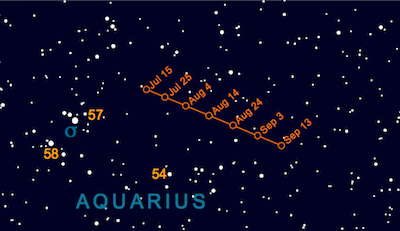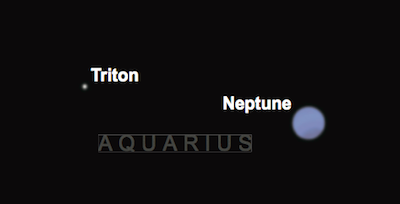



|

|

Neptune at its best
BY MARK ARMSTRONG
ASTRONOMY NOW
Posted: 28 August 2013

The most distant planet, remote and mysterious Neptune, is at its best, lying well south of the Celestial Equator among the stars of Aquarius.

Neptune tracks through Aquarius, gradually moving away from the fifth magnitude star sigma Aquarii. AN graphic by Greg Smye-Rumsby
Neptune shines at mag. +7.8, too faint to ever be seen with the naked-eye, but it can easily be tracked down in 10x50 binoculars and small telescopes. It can be found under two degrees west of 57-sigma Aquarii (mag. +4.8). Neptune has an equatorial diameter of 50,538 kilometers, 3.8 times that of Earth, but despite this, it's so remote at 4,334,280,970 kilometres or 28.9 AU (mean distance 30.1 AU) that its apparent diameter is a tiny 2.4 arcseconds.
To resolve the bluish-green disc requires a magnification of x100 at least so a 150-mm (6-inch) aperture would be a good choice, especially from the UK with the planetʼs low unfavourable altitude. From the southern USA and Australia, smaller 'scopes may be able to resolve the disc with the much more forgiving visibility closer to the zenith. Even large 'scopes will not reveal much if anything in the way of any surface markings (Paul Abel from the UK has produced some good observations and sketches) but imagers in the Southern Hemisphere should be able to secure some great images and try to emulate Damian Peaches remarkable achievement of recording dusky markings on the Neptunian disc.

Triton, Neptune's largest moon, is visible through a 200mm telescope at magnitude +13.8. AN graphic by Greg Smye-Rumsby
Neptune does have a large satellite, Triton, which at mag. +13.5 is visible in 'scopes in the 250mm-400mm class and on digital images. It never strays more than 17 arcseconds from its parents disc and so it's best to wait for when Triton is at maximum elongation to try for it. Triton is in a 5.9-day retrograde orbit that appears like a wide ellipse with Triton moving clockwise along its path (north up). This month Triton is at greatest eastern elongation on August 31, September 6 and September 11.
Neptune's southerly declination hinders UK observers at the moment. Neptune rises around 8pm BST and is 20 degrees above the south-east horizon by 10.30pm. It culminates 28 degrees up at 1am and its five-hour observing window ends at 3.30am when it sinks below 20 degrees above the south-west horizon. The ice giant remains on show in the evening sky for the rest of the year among the stars of Aquarius.
|

|

|

|
|



